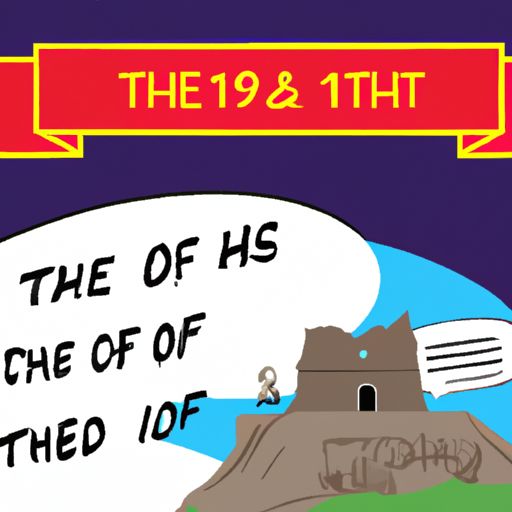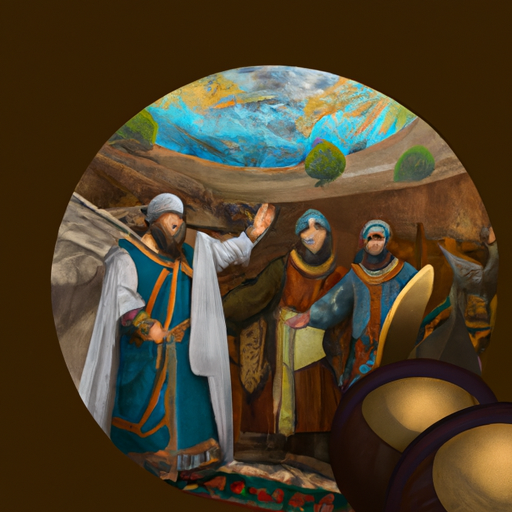Exploring the History of Female Vikings: Uncovering the Story of the ‘Shield-Maidens’
The tales of the female Vikings, warriors whose stories have been shrouded in the mists of time for centuries, are captivating. There is no one word to describe these women from the 8th to 11th century Scandinavian seafaring society; rather, many terms arose much later. A popular term is shieldmaiden, which first appeared in 1250 CE and was used by medieval authors to describe women who fought alongside men in battle. It is said that some even led troops into combat and commanded respect as skilled warriors.
Freyja and valkyrie are other terms that may be used to refer to female Vikings. These names refer to goddesses or supernatural figures in Norse mythology, often depicted as beautiful women wearing armor or riding horses alongside gods and heroes into battle. Freyja was associated with love and fertility while valkyries were believed to be spirits who chose which warriors would die in combat and carry them off to Valhalla – an afterlife paradise for those slain in war.
Ultimately, there is no single answer as to what we should call a girl Viking today; it depends on context and the individual being referred to. Whether it’s shieldmaiden or freyja or valkyrie, each term carries its own cultural significance and offers insight into the enigmatic lives of these extraordinary female warriors from history.
Introduction
Astonishingly, a female of the Scandinavian seafaring warriors of the 8th to 11th centuries was known as a ‘Girl Viking’. Derived from the Old Norse word víkingr, which conveys ‘pirate’ or ‘raider’, these Vikings were renowned for their raids and exploration voyages throughout Europe, Asia and even North America. Although frequently disregarded in history books, female Vikings were equally active in these raids and voyages as their male counterparts. In Norse culture, female Vikings were referred to as shieldmaidens or Valkyries.
– Historical Significance of Female Vikings
The oft-neglected history of female Vikings is no less pivotal in the annals of Scandinavia. Despite a society that was predominantly dominated by male warriors, there are numerous clues to suggest that women played an influential role during the Viking Age. Archaeological discoveries, such as graves with weapons and armor, imply that female Vikings were engaged in battle just as much as their male peers. Furthermore, certain artifacts found in these tombs hint at a higher social standing than the average person of the time, indicating that some women may have held positions of power or authority within their communities.
Literary accounts from this period also attest to the presence of female Vikings in prominent roles. The Icelandic sagas tell tales of courageous women like Freydis Eiriksdottir who led an expedition to North America and successfully defended her crew against hostile natives. Likewise, Lagertha is mentioned in the Gesta Danorum for her bravery alongside Ragnar Lothbrok while fighting off Norwegian invaders. These stories demonstrate how highly regarded female warriors were among Viking culture and further attest to their integral place in history.
In conclusion, it is essential to recognize and appreciate the contributions of female Vikings throughout Scandinavian history. Through various sources we can gain insight into their lives and roles within society during this era. Thus, it is important to acknowledge their importance within the larger context of Viking culture.
– A Look at Viking Women in Ancient Norse Society
A largely forgotten aspect of ancient Norse society is the influence of Viking women. Despite their significant role in the 8th to 11th centuries, their impact has been overlooked or downplayed. This article seeks to uncover the responsibilities and contributions of these remarkable women.
Viking women were highly respected within their communities, with evidence from written sources. They managed households, providing food for families and often taking on the roles of mediators between feuding parties and arbiters in legal cases. Moreover, they had the right to own property–inherited from fathers or husbands upon death.
Not only did Viking women take part in domestic duties, but also warfare. Though most warriors were male, there are accounts of female warriors fighting alongside men as shield-maidens–demonstrating courage and skill equal to that of their male counterparts.
Furthermore, Viking women had considerable sway over religious matters. Worshipping goddesses such as Freya or Idunn and serving as priestesses at temples dedicated to these gods and goddesses was commonplace. Additionally, many practiced divination or seidr–a form of sorcery used for healing or predicting the future–showing that they had power within Norse spiritual beliefs.
To conclude, Viking women played a pivotal role in ancient Norse society by making contributions to both domestic life and warfare while having influence over religious matters too. Their legacy is an important one that should be remembered and celebrated for its place in Scandinavian history.
– Examining the Role of Women in Viking History
The tales of the Vikings are full of heroic warriors and daring voyages, yet the part women played in this period is often overlooked. Women were a necessary part of Viking society, playing a major role in their families’ and communities’ day-to-day lives. Let us explore how they contributed to life in Scandinavia during this era.
Women’s roles depended on their social standing; some were farmers, merchants or artisans, while others served as healers or priestesses. Not only did many women provide for their families financially, but they also held positions of power within the community. They had influence over local politics, and if they inherited it from a male relative, could even own land.
Women were responsible for raising children and teaching them basic skills such as weaving and cooking. In certain cases, mothers would pass down knowledge about herbs and healing practices to their daughters – information which was essential for survival during that time period.
The Vikings viewed female strength as coming from within; they believed that women had the ability to protect their families from danger and bring success to their homes through hard work and commitment. This outlook was hugely influential in forming Viking culture; it enabled both men and women to be seen as equals regardless of gender roles.
In conclusion, examining the role of women in Viking history provides us with invaluable insight into life during this period. Women were strong figures who made an immense contribution to Viking society by playing multiple roles – from providing financially for their families to protecting them from harm – and we should recognize these accomplishments today.
– Exploring the Legacies of Female Viking Warriors
Venturing into the annals of Viking history can be a captivating experience. The Vikings, who lived in Scandinavia from the 8th to 11th centuries, were renowned for their maritime and plundering capabilities. While much of what we know about them comes from archaeological discoveries and written records, there is also evidence that women had a crucial role in Viking life. Female Viking warriors have been known to fight alongside their male counterparts in battle and even lead raids on their own.
The amount of respect female Viking warriors received from their peers has been subject to much speculation among historians. While some suggest they were viewed as equals, others propose they may have been regarded as inferior or second-class citizens. Nevertheless, there is proof that these women were respected within their communities and held influential positions.
Although no written accounts exist about female Viking warriors, archaeological findings give us an idea of what their lives were like. Weapons, armor, and jewelry have been unearthed with female remains at numerous sites across Scandinavia. This indicates that these women had access to riches and resources and were likely highly competent combatants.
The legacy of female Viking warriors continues to live on through popular culture such as books, films, television shows, video games, etc. By studying this history we can gain a better understanding of the part these women played in forming the culture and society of the Vikings.
– Investigating the Impact of Gender on Viking Age History
In the days of yore, gender had a vast effect on the annals of Scandinavian societies. Accounts from that era allude to men and women having distinct functions and obligations in their respective communities. Whilst men were mainly held responsible for battle, seafaring, and trading, women were largely accountable for running households and raising children. Nonetheless, current exploration has revealed that women also had essential parts in Viking society as warriors, traders, and craftspeople. This article will investigate how gender impacted Viking Age history by studying archaeological evidence from Norse settlements, sagas, and other primary sources. It will also consider how modern historians are utilizing this evidence to gain a more profound understanding of the lives of Viking males and females during this period. In conclusion, it is evident that gender had an immense influence on the progression of Viking Age history and culture.
conclusion
A female Viking was known by a special title — the shieldmaiden. This phrase, used in Norse and Germanic societies, symbolized the might of these female warriors. Throughout the Middle Ages, shieldmaidens were celebrated for their fearlessness, power, and prowess in combat. Their courage has been immortalized in history books.
Some questions with answers
Q1. What do you call a girl Viking?
A1. A female Viking is referred to as a shieldmaiden.
Q2. Is there evidence of female Vikings in history?
A2. Yes, there are archaeological and written records of female Vikings that suggest they were active participants in Norse society and warfare.
Q3. What roles did female Vikings play in history?
A3. Female Vikings had many roles, such as warriors, traders, craftspeople, leaders, and healers.
Q4. How did female Vikings fight in battle?
A4. Female Vikings fought with swords and axes just like their male counterparts. They also used shields for protection.
Q5. Are there any famous examples of female Vikings from history?
A5. Yes, the most famous example is probably Lagertha from the TV series “Vikings”. In real life, Gyda Eiriksdottir was an 11th-century Norwegian ruler who led her people against Harald Hardrada’s invasion forces.






